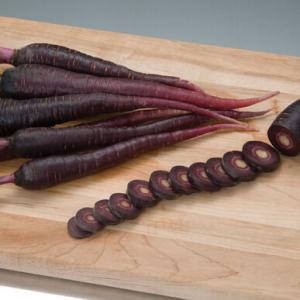Why plant orange carrots when you can plant several different purple carrots?
Who would think to use sea snail's mucus glands to dye cloth? The very rare, and therefore expensive, color purple was indeed made from the sea snail whose Latin name is purpura, where we get the word purple.
Purple dye was ridiculously expensive, so only royalty or the very rich could afford it.
The color purple does, in fact, affect us physically by calming your nerves, giving your spirits a lift, encouraging creativity and even spirituality.
In the garden, purple vegetables contain compounds called anthocyanins, which help reduce the risk of heart disease, stroke and metabolic diseases.
So why plant orange carrots when you can plant several different purple carrots?
Purple carrots often have a bit of an earthy taste, but Purple Haze carrot is milder than most. These have outstanding flavor, raw or cooked. The tapered roots grow seven to eight inches long with medium-short tops. While the skin is dark purple, the interior is glistering orange. When cooked, the color fades slightly.
Purple Haze won an award from the All American Selection for being an outstanding carrot. It is shaped like a Chantenay carrot with broad shoulders.
Another purple carrot is the Dragon carrot which also has deep-purple skin that contrasts with its bright-orange interior and light-yellow core. Sliced, it makes an eye-appealing addition to a dip tray. Dragon, with its thin, smooth skin, is cited as the most refined purple carrot to grow. Because of its smooth skin, Dragon is easier to clean than many other carrots, so it can be served unpeeled.
Dragon can stay in the garden unpicked without getting tough or woody. This is a strong-growing carrot that often can out-compete weeds.
Purplesnax is one of the sweetest carrots grown, and is popular as a snack food for kids. The roots are straight and narrow like a Nantes or Imperator carrot. Purplesnax is quite forgiving and will produce good crops, even in less-than-ideal conditions.
Deep Purple is a hybrid carrot with deep purple all the way to the core. The color fades during cooking. It is a good choice for juicing.
Sow carrot seeds outdoors whenever the ground can be worked, about three to four weeks before your last spring frost. Plant the seeds a quarter-inch deep, half an inch apart in rows 16-24 inches apart.
Once the carrots have sprouted, thin so they are two to four inches apart in the row. Plant new seeds every two weeks so you have a continuous supply of purple carrots.
Oh, and as for no words rhyming with purple? There is “curple,” the strap under the girth of a horse’s saddle, which keeps the saddle from moving forward. And if you have a “hirple,” you walk with a limp.
So, plant purple carrots for their novelty, and as one of the most nutritious vegetables you can grow, and you will walk, not hirple, in the garden.






















































